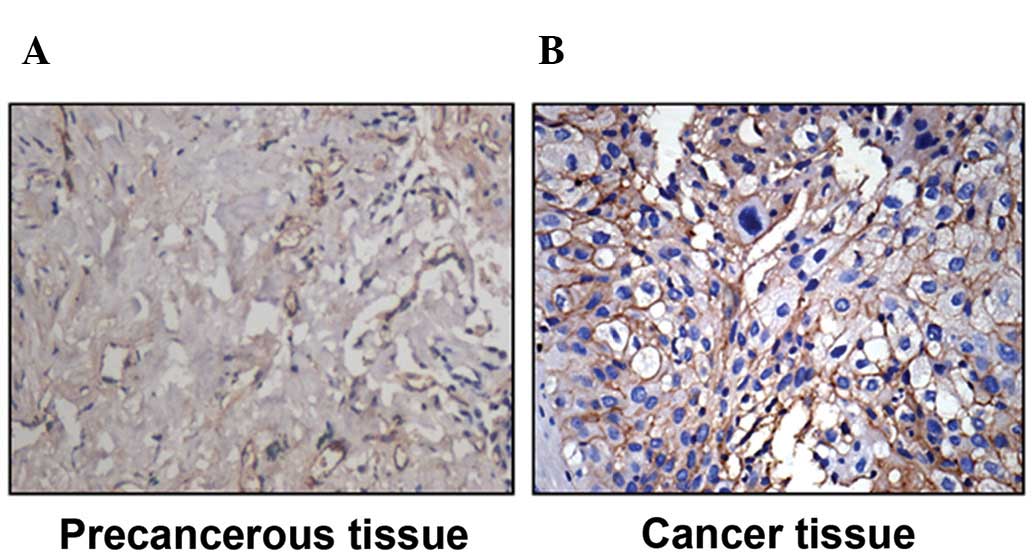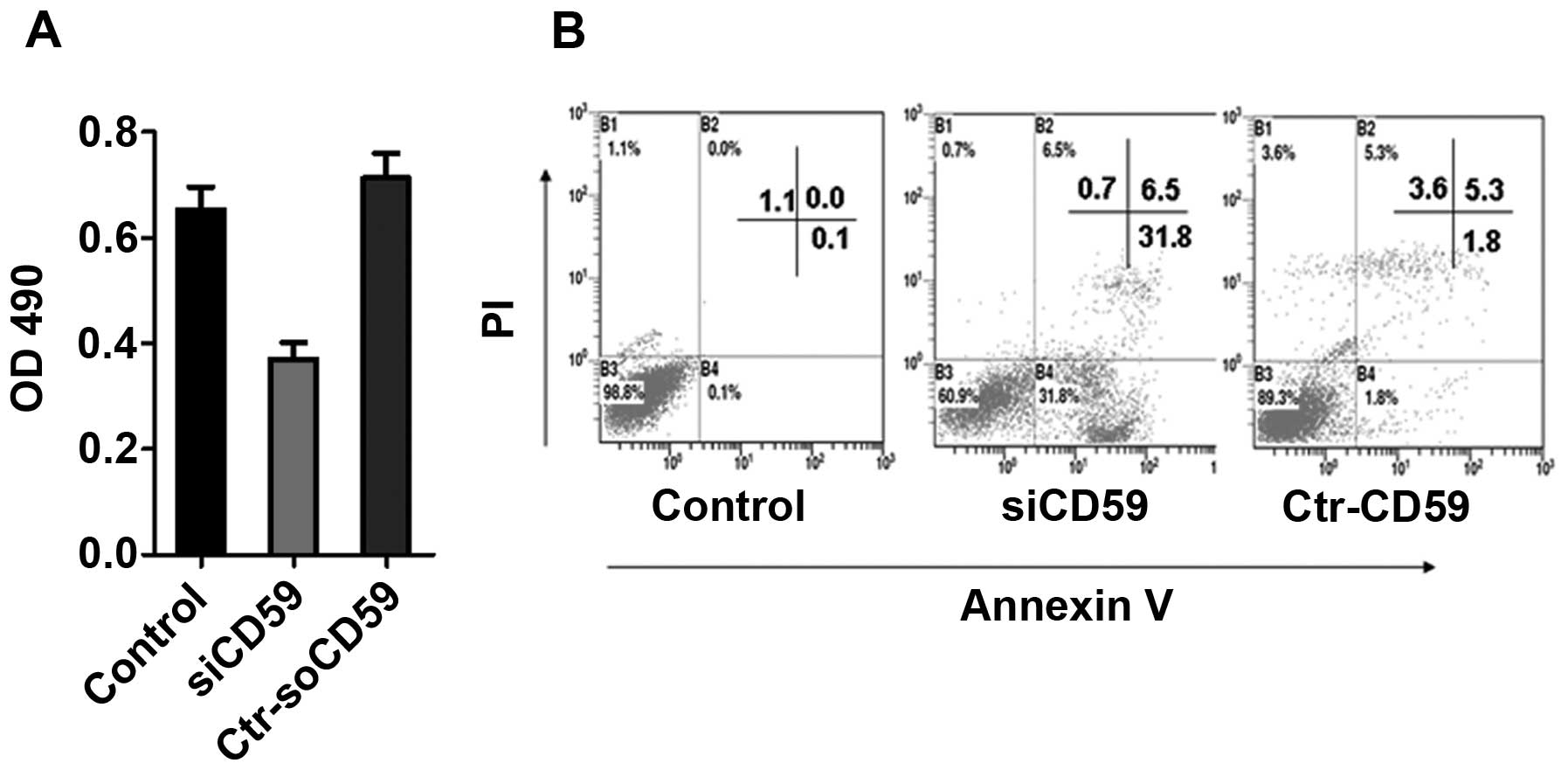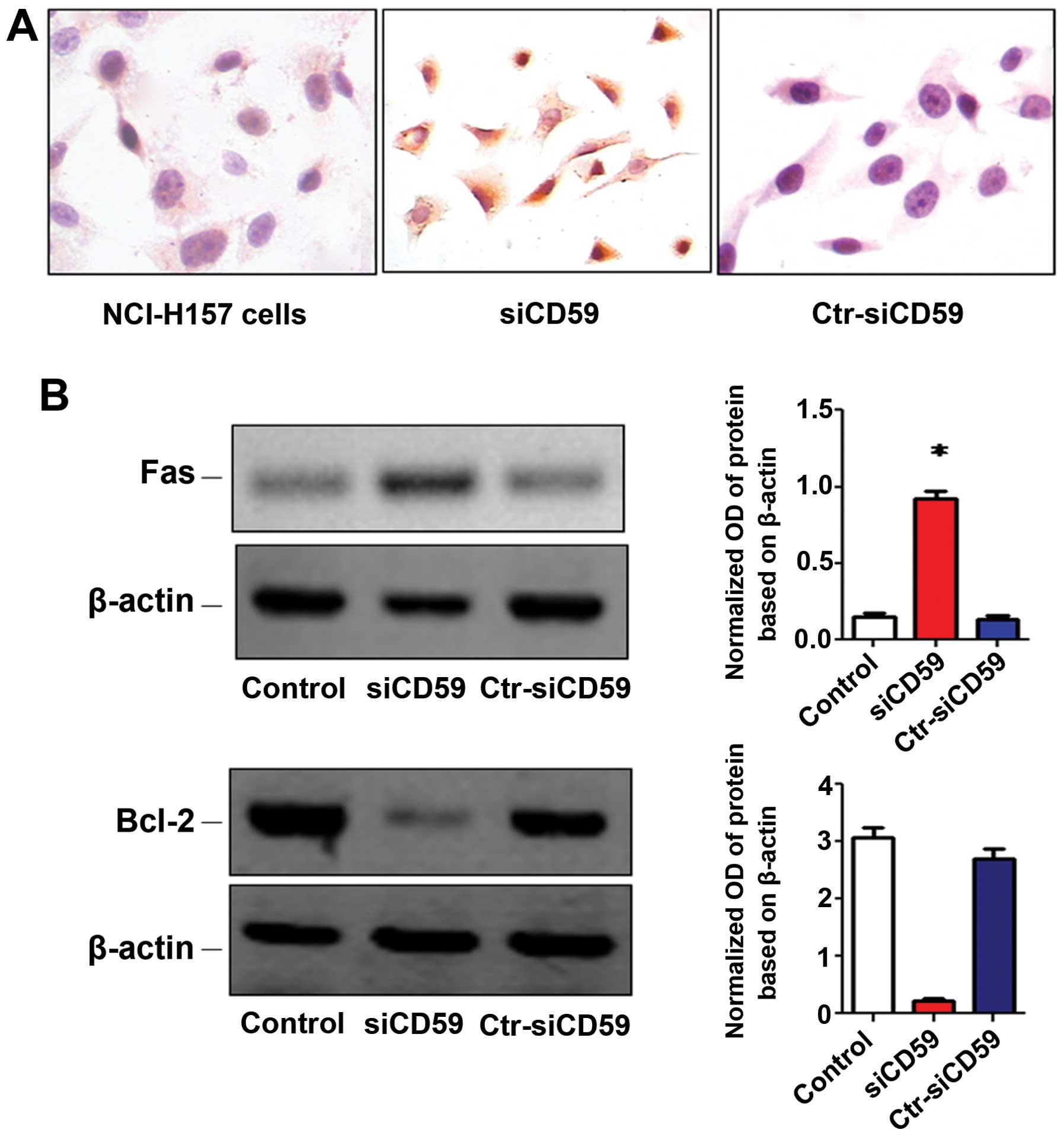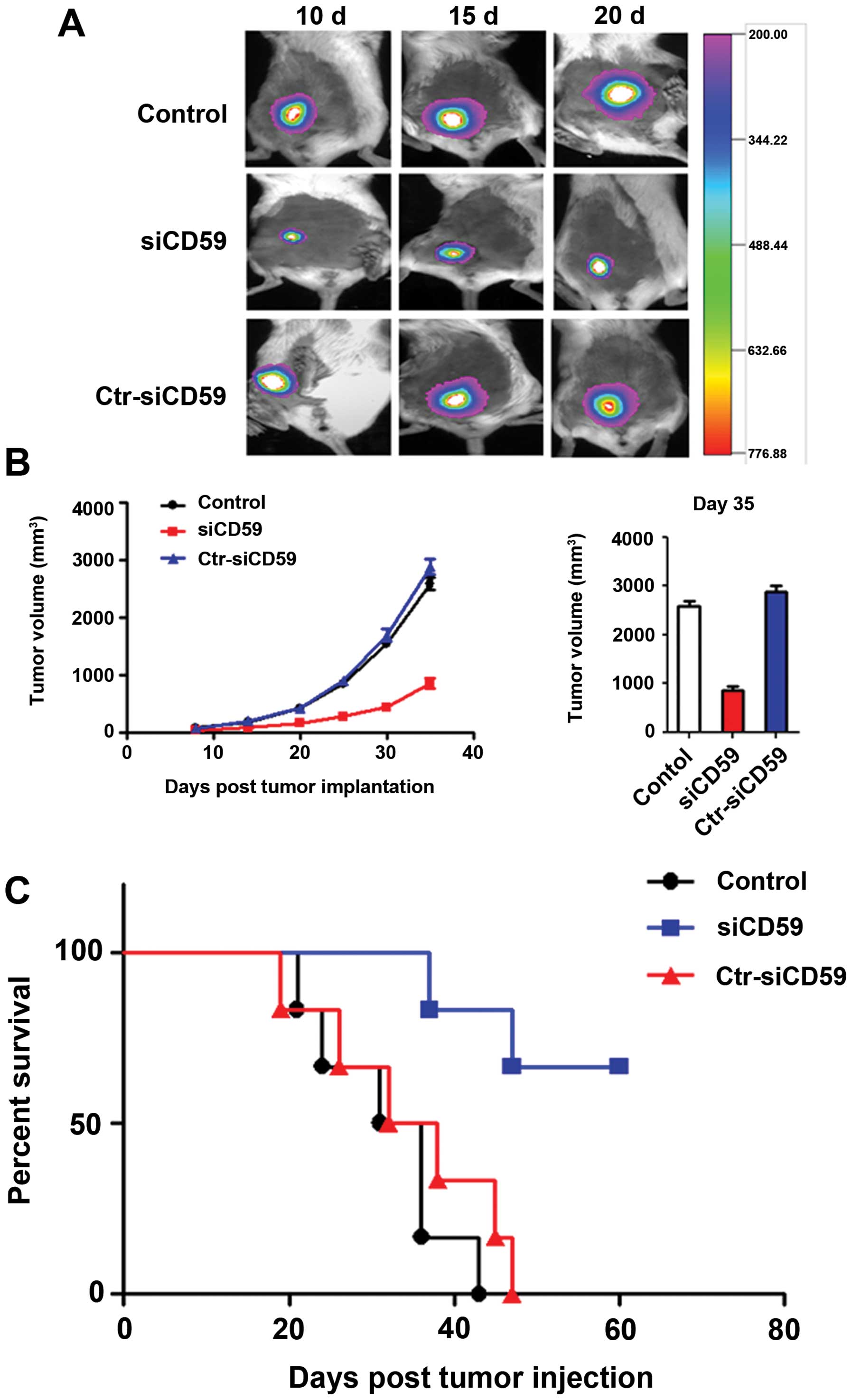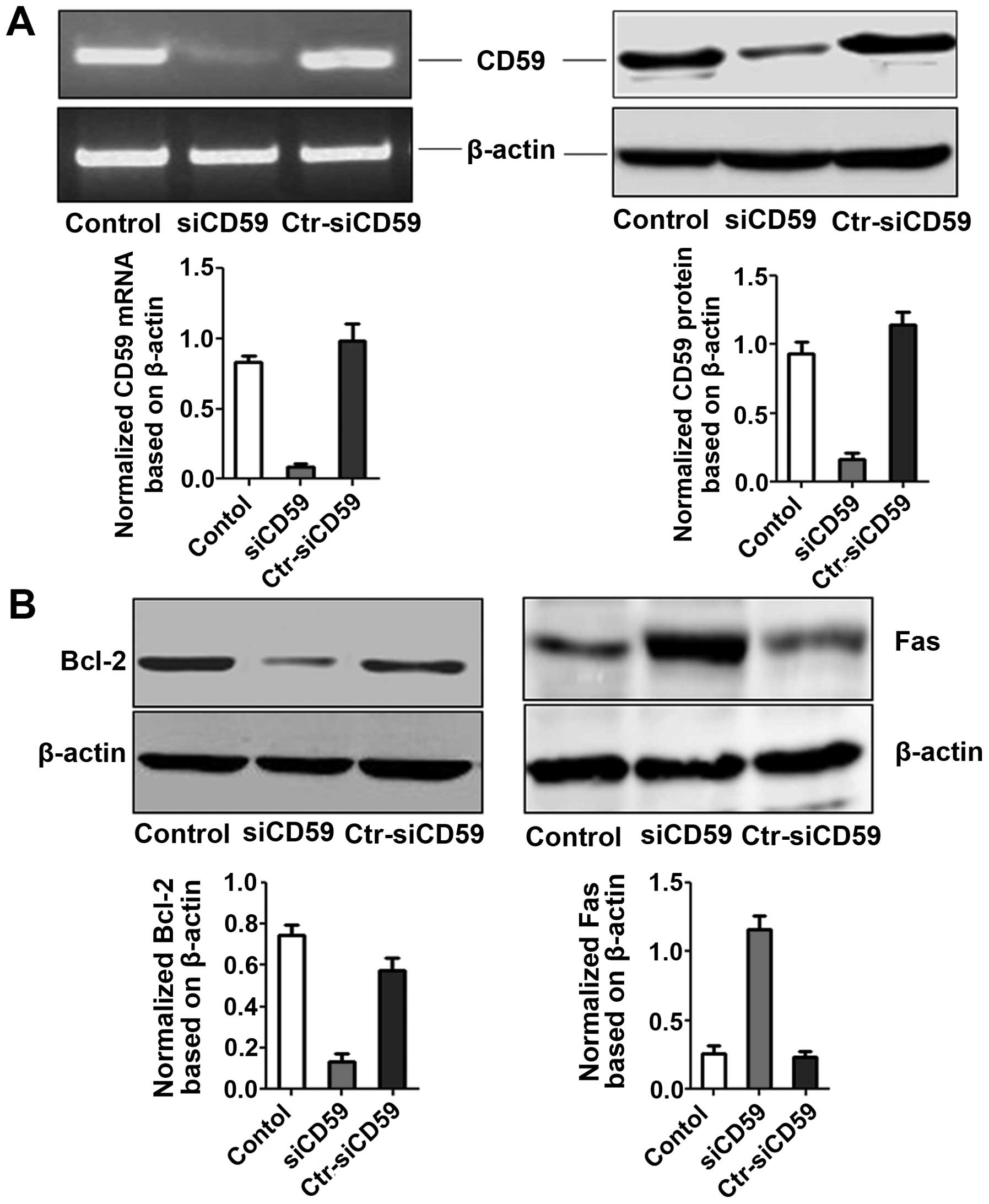CD59 is overexpressed in human lung cancer and regulates apoptosis of human lung cancer cells
- Authors:
- Published online on: July 5, 2013 https://doi.org/10.3892/ijo.2013.2007
- Pages: 850-858
Abstract
Introduction
Lung cancer is the most common cancer worldwide and the leading cause of cancer-related mortality (1). Non-small cell lung cancer (NSCLC) accounts for ~80% of all lung cancer cases and has a 5-year overall survival rate of <15% (2,3). Approximately 40% of patients diagnosed with NSCLC have unresectable stage III disease or inoperable disease (4). Therefore, additional efforts are needed to understand and identify molecular targets for gene therapy (5,6).
The cluster of differentiation 59 (CD59), also called protectin, is a type of complement regulated proteins (CRPs). CD59 inhibits the complement cytolytic activity by binding to C8 and C9, which blocks the assembly of the membrane attack complex (MAC) (7). CD59 is overexpressed in most solid malignancies and presents at low levels in normal tissues. CD59 overexpression may assist malignant cells to escape immunologic surveillance and complement-mediated cytolysis, limiting the effect of complement-fixing monoclonal antibodies (7–10). Immune escape of tumor cells is a primary cause of failed immunotherapy. Blocking of CD59 function on the surface of tumor cells might allow effective complement-mediated clearance of tumor cells that improve the effect of complement-activating antitumor antibodies (11,12). Therefore, CD59 is a promising therapeutic target for antitumor gene therapy.
RNA interference (RNAi) is an economical, fast and highly efficient technique for silencing gene expression (13–15). Recently, siRNA-encoding plasmids delivered by virus has been rapidly developed and widely applied in mammalian cells (16,17). In this study, we examined the expression of CD59 in NSCLC and constructed a CD59 small interfering RNA (siRNA) lentiviral vector. We assessed its effect on the proliferation and apoptosis of lung cancer cells and further characterized the functional role of CD59 during lung cancer tumorigenesis.
Materials and methods
Expression of CD59 in tissue specimens by immunohistochemistry (IHC)
Twenty primary NSCLC specimen and corresponding surgical margin specimens were obtained from the People’s Hospital of Guangxi Zhuang Autonomous Region. A mouse polyclonal antibody for CD59 was obtained from Santa Cruz Biotechnology (SC-133171) to assess the expression of the CD59 protein. Briefly, paraffin-embedded tissue sections (5-μm thick) were deparaffinized with xylene and then dehydrated in sequential diluted ethanol before rinsing in PBS. Sections were heated for 10 min in 0.01 M citrate buffer (pH 6.0) twice to unmask the antigens. Endogenous peroxidase activity was then blocked with 3% hydrogen peroxide for 20 min at room temperature. Before being incubated with CD59 antibody (dilution, 1/100 in 0.01 M PBS) at 4°C overnight, sections were incubated with 5% normal goat serum in 1% BSA in PBS for 30 min to block non-specific IgG binding. A biotinylated goat antimouse IgG was used for further incubation and a strepavidin-biotin complex system (SABC) with diaminobenzidene as chromogen was used for color development. The sections were weakly counterstained with hematoxylin before mounting and then examined under a light microscope. PBS (0.01 M) was used to replace primary antibody to serve as negative staining controls. Immunohistochemical staining was evaluated by two independent pathologists.
Construction of small interfering RNA targeted CD59 expression vector, production of lentivirus and transfection into NCI-H 157 cells
The pSUPER vector was digested by BglII and HindIII restriction enzyme and annealed oligos, siCD59: 5′-GATCCCCGCGTGTCTCATTACCAAAGttcaagagaCTT TGGTAATGAGACACGTTTTA-3. siCD59-C: 5′-AGCTTA AAAAGCGTGTCTCATTACCAAagtctcttgAACTTTGGTA ATGAGACACGCGGG-3′ were ligated with this vector. The recombinants were identified by PCR, restriction endonuclease analyses and DNA sequencing, respectively.
A packaging cell line Phoenix A and human non-small lung cancer cell line NCI-H157 cells (18) were cultured in DMEM and RPMI-1640 supplemented with 10% FBS (Gibco, Carlsbad, CA, USA) and penicillin/streptomycin, incubating in a humidified incubator (37°C, 5% CO2). For retroviral production, Phoenix A cells were transfected with this recombinant using Lipofectamine 2000 (Invitrogen, Carlsbad, CA, USA) according to the manufacturer’s instructions. Culture supernatants were collected after 48 h. NCI-H157 cells were infected with siCD59 and siCD59-C in the presence of 8 g/ml polybrene, follow by clonal selection with G418 (400 mg/l) to generate stable clones.
Detection of the expression of CD59 mRNA by real-time quantitative PCR (RT-qPCR) test
Total RNA from different groups of NCI-H157 cells was isolated using TRIzol reagent (Invitrogen). Two microgram of total RNA was reverse-transcribed in a 20-μl reaction using reverse-transcription system (Promega, Madison, WI, USA). Primers were designed based on sequences of human CD59 and β-actin. The forward primer of CD59 was 3′-ACACCATTGCTGGGGACCTC-5′ and the reverse primer was 3′-GCTGAATCTTAAAGTCAGGCAA AGG-5′. The forward primer of β-actin was 3′-CACACCCGC CACCAGTTCGC-5′ and the reverse primer was 3′-AGCACAG GGTGCTCCTCAGGG-5′. The amplified sequence was 356 and 332 bp, respectively. Thermo cycling was carried out as follows: CD59; 94°C for 5 min, then 40 cycles of 94°C for 45 sec, 52°C for 45 sec and 72°C for 45 sec, followed by 72°C for 7 min or β-actin 94°C for 5 min, then 40 cycles of 94°C for 40 sec, 58°C for 35 sec and 72°C for 45 sec, followed by 72°C for 7 min. PCR products were quantified by using Quantity One 6.4.0 (Bio-Rad, Hercules, CA, USA) Software. CD59 levels were normalized to β-actin.
Determination of CD59 protein expression by western blotting
Different groups of NCI-H157 cells were harvested at the indicated time-points, washed twice with cold phosphate-buffered saline (PBS), lysed in fresh cell lysis buffer for 2 h on ice and centrifuged at 12,000 g for 15 min at 4°C to remove insoluble materials. Protein concentrations were determined by BCA assay. Protein (20 μg) was separated by using 8 and 5% sodium dodecyl sulfate-polyacrylamide gel electrophoresis and transferred to PVDF membranes. The membrane was incubated with anti-CD59 (1:500) and anti-β-actin (1:200) antibodies (Santa Cruz Biotechnology, Inc., Santa Cruz, CA, USA), respectively, followed by incubation with horseradish peroxidase-conjugated goat anti-mouse secondary antibody. Western blots were developed by chemiluminescence and quantified using Quantity One 6.4.0 (Bio-Rad) software. CD59 levels were normalized to β-actin.
Determination of the NSCLC cell proliferation by MTT assay
Different groups of NCI-H157 cells were cultured for 3 days in 96-well plates and then incubated in 5% MTT at 37°C for 4 h. DMSO (100 μl/well) was added and the light absorption value at 490 nm was measured.
Determination of the NSCLC cell apoptosis by flow cytometry
Different groups of NCI-H157 cells were seeded in 6-well culture plates. Each group contained five culture flasks. After 24 h, the cells were harvested and washed in cold PBS. Annexin V and PI staining were carried out using the Annexin V-FITC Apoptosis Detection kit (BD Biosciences, USA), according to the manufacturer’s protocol. After a 20-min incubation in the dark at room temperature, the cells were immediately analyzed by FACSCalibur Flow Cytometry (BD Biosciences).
Determination of the NSCLC cell resistance to complement cracking ability by LDH release test
Different groups of NCI-H157 cells were treated with complement inactivated 8% fresh normal human serum (NHS) for 60 min at 37°C. Triton X-100 (0.1%) in RPMI-1640 was used as the 100% lysis control and RPMI-1640 alone was used for the 0% lysis control. Following incubation, 40 μl of sample supernatant was taken for LDH assay. To each well 100 μl solution C was added. Just before analysis, 10 μl solution B was added. The absorbance at 440 nm was calculated, reflecting the activity of LDH present and the following equation applied: LDH leakage rate.
Detection of the expression of caspase-3 in cells by immunohistochemistry (IHC)
Different groups of NCI-H157 cells (2×104 ml) were seeded onto glass coverslips for 48 h. After incubation with fresh NHS for 6 h, the cover slips were washed thrice with PBS, 2% PBS-paraformaldehyde solution was added for 15 min at room temperature and 0.4% Triton X-100 was added at room temperature for 15 min. After washing thrice with PBS, the cells were treated with 30% H2O2. The caspase-3 protein expression levels were measured by IHC staining. In brief, cells were incubated in blocking buffer at room temperature for 20 min, followed by the rabbit antihuman caspase-3 antibody (1:500 Abcam, Cambridge, MA, USA) at 4°C overnight followed by an additional washing step (3X) with PBS. Secondary antibody labeled with HRP (mouse anti-rabbit) was added and incubated at 37°C for 1 h followed by washing (3X) with PBS. SABC was added at 37°C for 20 min and DAB at room temperature for 5–30 min and the results were observed under a light microscope. Positive cells were stained brownish yellow. Caspase-3 protien levels were determined by positive index = positive percentage (%) × mean optical density × 100.
Determination of Bcl-2 and Fas protein by western blotting
Total protein extraction of different groups of NCI-H157 was performed, as described above. Twenty microgram (20 μg) was separated using 8 and 5% sodium dodecyl sulfate-polyacrylamide gel electrophoresis and transferred to PVDF membranes. The membrane was incubated with anti-bcl-2 (1:500), anti-Fas (1:10,000) and anti-β-actin (1:200) antibodies (Santa Cruz), followed by incubation with horseradish peroxidase-conjugated goat anti-mouse secondary antibody. Western blots were developed by chemiluminescence and bands were quantified by using Quantity One 6.4.0 (Bio-Rad) software. CD59 levels were normalized to β-actin.
Xenograft studies
Athymic male nude mice (5- to 6-week-old) were purchased from Laboratory Animal Centre of Guangxi Medical University and housed under pathogen-free conditions. All animal experiments were reviewed and approved by the Institutional Animal Care and Use Committee of the Guangxi Medical University. Thirty mice were randomly divided into three groups of 10 each: control group, siCD59 groups and siCD59-ctr groups. Each mouse of every group was subcutaneously respectively injected with 2×105 luciferase-expressing Luc-NCI-H157 cell, siCD59 and siCD59-ctr cells (Invitrogen) into the right flank. Tumor growth/regression was monitored every 5 day by in vivo imaging after intraperitoneal injection of firefly luciferin (150 mg/kg) to the mice using an non-invasive imaging system (Roper, USA). Each mouse cohort was also monitored for 60 days to determine the tumor volume and the survival rate.
Determination of CD59 mRNA and CD59, Bcl-2 and Fas protein expression in vivo
Mice were sacrificed at the end of the experiments by CO2 asphyxiation. Tumors were excised and immediately snap-frozen in liquid nitrogen. Total RNA and protein extraction of tumor tissue were frozen in liquid nitrogen. CD59 mRNA expression was determined by RT-PCR and CD59, Bcl-2, Fas protein was determined by western blotting.
Statistical analysis
Data were analyzed using GraphPad Prism 5.0 statistical software. Quantitative data were expressed as the means ± standard deviation. Significant difference was determined by P-values <0.05.
Results
Expression of CD59 in lung cancer
CD59 expression was significantly higher in tissues from non-small cell lung carcinoma (NSCLC) than in preneoplastic tissue (67.6 vs. 4.3%, P<0.05) (Fig. 1).
CD59-siRNA efficiently suppressed CD59 expression
Recombinant retroviruses siCD59 and siCD59-control (siCD59-C) both contain a green fluorescent protein (GFP) reporter gene, which allowed for measuring infection efficiency in NCI-H157 cells. Forty-eight hours post-infection, the infection efficiency was ~70% in both siCD59 and siCD59-C infected cells (Fig. 2). CD59 mRNA and protein levels were decreased significantly in siCD59 infected cells compared to siCD59-C infected cells (Fig. 3).
Effect of CD59-siRNA on lung cancer cell proliferation and apoptosis
To determine the effect of CD59 knockdown on the growth of NCI-H157 cells, an MTT assay was performed on NCI-H157 cells, siCD59 and siCD59-C transfected NCI-H157 cells. SiCD59-transfected NCI-H157 cells displayed a significant decrease in growth rate compared to siCD59-C-transfected cells and NCI-H157 cells (Fig. 4A). To determine the effects of CD59 knockdown on cell apoptosis, flow cytometry were used. Knockdown of CD59 increased apoptosis of NCI-H157 cells compared to NCI-H157 cells and siCD59-ctr cells (31.8% P>0.1%, P>0.05; 31.8% P>0.18%, P>0.05) (Fig. 4B).
CD59-siRNA reduced cell viability and increased cell damage when treated with complement
The viability and cellular DNA damage of siCD59-NCI-H157 transfected cells was also reduced and increased, respectively, compared to the siCD59-C cells and NCI-H157 cells (Table I).
CD59-siRNA affects expression of caspase-3, Fas and Bcl-2
Shi et al(6) demonstrated that apoptosis could modulate the expression of CD59. IHC and western blot analysis showed increased caspase-3 (Fig. 5A) and Fas (Fig. 5B) levels while Bcl-2 (Fig. 5B) levels were decreased in siCD59-transfected NCI-H157 cells and NCI-H157 cells. These results indicate that CD59 regulates apoptosis in non-small cell lung cancer cells.
Knockdown of CD59 suppresses lung cancer cell growth in vivo
To test whether loss of CD59 can suppress lung cancer progression, we performed a xenograft study whereby different groups of NCI-H157 cells were subcutaneously injected into mice. Tumors were allowed to reach a size such that ~108 photons/sec/cm2 were emitted following luciferin processing. Subsequently, luciferase signals in tumors of mice were detected in 10, 15 and 20 days after post-injection. Compared to s-CD59-C tumors and NCI-H157 cells, significant decrease in tumor burden was observed upon CD59 knockdown (Fig. 6A and B). The survival rate of tumor-bearing mice at 60 days was 70, 0 and 0% in siCD59-transfected tumors group, siCD59-C tumors group and NCI-H157 tumors group (Fig. 6C).
In vivo expression of CD59 mRNA and CD59, Bcl-2 and Fas protein
Total RNA and protein were extracted from tumor tissues to determine CD59 levels. Robust decrease in CD59 levels at both the RNA and protein levels were observed in siCD59 cells compared to siCD59-C cells and NCI-H157 cells (Fig. 7A). Furthermore, Fas and Bcl-2 expression was significantly increased and decreased, respectively, in siCD59 cells compared to siCD59-C and NCI-H157 cells (Fig. 7B).
Discussion
Human CD59 is an 18–20 kDa protein anchored through glycanphosphatidylinositol (GPI) to the cell membrane (19). CD59 belongs to the members of Ly6 superfamily (20). The functions of CD59 protein are mainly involved in the following three aspects. First, CD59 functions as an inhibitor of the C5b-9 membrane attack complex (MAC) of human complement (21). Second, CD59 acts as the second signal stimulant, inducing the activation of T lymphocytes and taking part in the regulatory course of immunoreactions (22). Third, CD59 is the ligand of CD2 that can conglutinate with CD59. CD59-CD2 complex activates T cells and then guides adhesion of T and T cells or T and other tissue cells and further regulates the growth of tissue cells (23).
Previous studies have shown that CD59 is highly expressed in many types of tumors, including breast cancer (24–27), colorectal cancer (26,28,29), ovarian cancer (30), malignant gliomas (31), malignant lymphomas (32), prostate cancer (33) and pancreatic cancer (34) and it directly or indirectly participates in carcinogenesis and tumorigenesis. Our studies focused on the role of CD59 during tumorigenesis of NSCLC cells (NCI-H157) upon silencing CD59.
In the present study, we first detected high expression of CD59 in tissues of patients with lung cancer (Fig. 1). CD59 expression in non-small cell lung cancer tissues is much higher than in the surrounding tissue based on IHC. This suggests that CD59 might be a new biomarker for lung cancer progression.
RNA interference has emerged as a genetic tool for silencing gene expression. Because siRNA can be integrated into the host genome, long-term gene silencing can be achieved of siRNAs (17,35). Retroviral infection of siCD59 to NCI-H157 cells was able to significantly decrease CD59 mRNA and protein levels compared to siCD59-C cells (Fig. 3). Knockdown of CD59 decreased cell viability and increased cell damage and apoptosis of lung cancer cells (Fig. 4). Furthermore, CD59 knockdown also reduced tumor growth in vivo (Fig. 6).
Loss of CD59 can induce complement-mediated cytolysis and lead to apoptosis of tumor cells (5). Complement-mediated cytolysis can also assist in apoptosis by inducing phagocytosis (36,37). MAC-triggered cell death can occur through a caspase-dependent pathway, specifically via caspase-3. Animal models of renal disease also implicate that MAC can trigger apoptosis (38–40). Korty et al demonstrated that CD59 can also increase calcium flux to increase cytoplasmic calcium levels which induces mitochondrial DNA damage and cytochrome c(41). Fas expression also initiates apoptosis under certain conditions and Fas antigen and ICAM-1 molecule can have a synergistic effect (42). Bcl-2 has also emerged as a proto-oncogene that blocks programmed cell death independently of promoting cell division (43). Bcl-2 can inhibit the synthesis and activation of caspase-3 to inhibit apoptosis. Moreover, Bcl-2 can also be degraded by caspase-3 a specific enzyme, which activates apoptosis. Apoptosis can inhibit tumorigenesis by removing unwanted and damaged cells (52).
Cell apoptosis typically occurs during tumor development and regression. Therefore, an important mechanism to prevent tumorigenesis is the induction of cell apoptosis that takes place continuously in many tissues to remove unwanted, damaged or aberrant cells. In this study, we investigated the effects of CD59 silencing to understand the biochemical mechanism underlying CD59 inactivation-induced apoptosis. We also studied the role of CD59 in regulating the growth and apoptosis of NCI-H157 cells. We showed that CD59 knockdown significantly decreased the growth and increased apoptosis of NCI-H157 cells compared to siCD59-C cells (Fig. 4), consistent with previous observations (44,45). CD59-induced apoptosis might be mediated by MAC. Further studies are needed to understand this mechanism.
NCI-H157 cells treated by human complement (NHS, 8%, v/v) were used to assess MAC-mediated cytolysis. We showed that CD59 knockdown significantly inhibited the viability of NCI-H157 cells (Table I), decreased Bcl-2 expression and increased caspase-3 and Fas expression (Fig. 5). Caspases are executioners of apoptosis and regulate Fas/TNF-R1, mitochondria dysfunction and TNF-related apoptosis-inducing ligand (TRAIL). Caspase-3 activation was observed upon Fas/TNF-R1 treatment (Fig. 5A). Overall, the present data suggest that the loss of CD59 induces caspase-dependent apoptosis in cultured cells.
To investigate the inhibitory role of siCD59 in vivo, siCD59 infected cells were injected into athymic nude mice. Knockdown of CD59 significantly decreased tumor weight and growth and increased the survival rate of mice compared to siCD59-C cells and NCI-H157 cells (Fig. 6), which suggests that silencing CD59 gene expression could markedly inhibit the growth of cancer in vivo. The silencing of CD59 expression in tumor tissue was confirmed by RT-PCR and western blotting (Fig. 7A), which showed significantly less CD59 expression in siCD59 group than in siCD59-C group, or the NCI-H157 cell group. Decreased tumor growth could be attributed to apoptosis, as indicated by Fas and Bcl-2 expression in these tumor tissues (Fig. 7B). The present data suggest that the CD59 loss induces caspase-dependent apoptosis in vitro and in vivo.
Overall, our study illustrates that CD59 is increased in human lung cancer and loss or inactivation of CD59 can lead to apoptosis of NCI-H157 lung cancer cells. This may be mediated by inducing Fas expression on the surface of NCI-H157 cells, leading to apoptosis through caspase-3 activation and complement-induced cytolysis. This might provide insight into new treatment for lung cancer patients by inhibiting CD59 expression.
In conclusion, the present study demonstrates that CD59 is overexpressed in human lung cancer and retroviral-mediated RNAi delivery is an efficient system for CD59 gene silencing of human lung cancer. Suppression of CD59 expression enhanced complement-mediated cytolysis of lung cancer cells, which may be mediated by induction of Fas expression on the surface of NCI-H157 cells, leading to apoptosis through caspase-3 activation, CD59 may serve as a candidate targeting gene in gene therapy for human carcinomas such as lung, ovarian, prostate carcinoma and cervical carcinoma.
Acknowledgements
This study was supported by Grants from the Scientific Research and Technological Development Projects of Guangxi, China (no. 0816004-8).
References
|
Parkin DM, Bray F, Ferlay J and Pisani P: Global cancer statistics, 2002. CA Cancer J Clin. 55:74–108. 2005. View Article : Google Scholar | |
|
Fidias P and Novello S: Strategies for prolonged therapy in patients with advanced non-small-cell lung cancer. J Clin Oncol. 28:5116–5123. 2010. View Article : Google Scholar : PubMed/NCBI | |
|
Fuld AD, Dragnev KH and Rigas JR: Pemetrexed in advanced non-small-cell lung cancer. Expert Opin Pharmacother. 11:1387–1402. 2010. View Article : Google Scholar : PubMed/NCBI | |
|
Whitehurst AW, Bodemann BO, Cardenas J, et al: Synthetic lethal screen identification of chemosensitizer loci in cancer cells. Nature. 446:815–819. 2007. View Article : Google Scholar : PubMed/NCBI | |
|
Li B, Chu X, Gao M and Xu Y: The effects of CD59 gene as a target gene on breast cancer cells. Cell Immunol. 272:61–70. 2011. View Article : Google Scholar : PubMed/NCBI | |
|
Shi XX, Zhang B, Zang JL, Wang GY and Gao MH: CD59 silencing via retrovirus-mediated RNA interference enhanced complement-mediated cell damage in ovary cancer. Cell Mol Immunol. 6:61–66. 2009. View Article : Google Scholar : PubMed/NCBI | |
|
Fonsatti E, Altomonte M, Coral S, et al: Emerging role of protectin (CD59) in humoral immunotherapy of solid malignancies. Clin Ter. 151:187–193. 2000.PubMed/NCBI | |
|
Chen S, Caragine T, Cheung NK and Tomlinson S: CD59 expressed on a tumor cell surface modulates decay-accelerating factor expression and enhances tumor growth in a rat model of human neuroblastoma. Cancer Res. 60:3013–3018. 2000.PubMed/NCBI | |
|
Wickham SE, Hotze EM, Farrand AJ, et al: Mapping the intermedilysin-human CD59 receptor interface reveals a deep correspondence with the binding site on CD59 for complement binding proteins C8alpha and C9. J Biol Chem. 286:20952–20962. 2011. View Article : Google Scholar : PubMed/NCBI | |
|
Gelderman KA, Tomlinson S, Ross GD and Gorter A: Complement function in mAb-mediated cancer immunotherapy. Trends Immunol. 25:158–164. 2004. View Article : Google Scholar : PubMed/NCBI | |
|
Fishelson Z, Donin N, Zell S, Schultz S and Kirschfink M: Obstacles to cancer immunotherapy: expression of membrane complement regulatory proteins (mCRPs) in tumors. Mol Immunol. 40:109–123. 2003. View Article : Google Scholar : PubMed/NCBI | |
|
Fonsatti E, Di Giacomo AM and Maio M: Optimizing complement-activating antibody-based cancer immunotherapy: a feasible strategy? J Transl Med. 2:212004. View Article : Google Scholar : PubMed/NCBI | |
|
Sioud M: Promises and challenges in developing RNAi as a research tool and therapy. Methods Mol Biol. 703:173–187. 2011. View Article : Google Scholar : PubMed/NCBI | |
|
Ashihara E: RNA interference for cancer therapies. Gan To Kagaku Ryoho. 37:2033–2041. 2010.PubMed/NCBI | |
|
Ashihara E, Kawata E and Maekawa T: Future prospect of RNA interference for cancer therapies. Curr Drug Targets. 11:345–360. 2010. View Article : Google Scholar : PubMed/NCBI | |
|
Brummelkamp TR, Bernards R and Agami R: A system for stable expression of short interfering RNAs in mammalian cells. Science. 296:550–553. 2002. View Article : Google Scholar : PubMed/NCBI | |
|
Sui G, Soohoo C, Affar el B, Gay F and Shi Y, Forrester WC and Shi Y: A DNA vector-based RNAi technology to suppress gene expression in mammalian cells. Proc Natl Acad Sci USA. 99:5515–5520. 2002. View Article : Google Scholar : PubMed/NCBI | |
|
Shafer SH and Williams CL: Non-small and small cell lung carcinoma cell lines exhibit cell type-specific sensitivity to edelfosine-induced cell death and different cell line-specific responses to edelfosine treatment. Int J Oncol. 23:389–400. 2003.PubMed/NCBI | |
|
Geis N, Zell S, Rutz R, et al: Inhibition of membrane complement inhibitor expression (CD46, CD55, CD59) by siRNA sensitizes tumor cells to complement attack in vitro. Curr Cancer Drug Targets. 10:922–931. 2010. View Article : Google Scholar : PubMed/NCBI | |
|
Fleming TJ, O’HUigin C and Malek TR: Characterization of two novel Ly-6 genes. Protein sequence and potential structural similarity to alpha-bungarotoxin and other neurotoxins. J Immunol. 150:5379–5390. 1993. | |
|
Sugita Y, Nakano Y, Oda E, Noda K, Tobe T, Miura NH and Tomita M: Determination of carboxyl-terminal residue and disulfide bonds of MACIF (CD59), a glycosyl-phosphatidylinositol-anchored membrane protein. J Biochem. 114:473–477. 1993. | |
|
Treon SP, Shima Y, Grossbard ML, Preffer FI, Belch AR, Pilarski LM and Anderson KC: Treatment of multiple myeloma by antibody mediated immunotherapy and induction of myeloma selective antigens. Ann Oncol. 11(Suppl 1): 107–111. 2000. View Article : Google Scholar : PubMed/NCBI | |
|
Zaltzman AB, Van den Berg CW, Muzykantov VR and Morgan BP: Enhanced complement susceptibility of avidin-biotin-treated human erythrocytes is a consequence of neutralization of the complement regulators CD59 and decay accelerating factor. Biochem J. 307:651–656. 1995. | |
|
Hakulinen J and Meri S: Expression and function of the complement membrane attack complex inhibitor protectin (CD59) on human breast cancer cells. Lab Invest. 71:820–827. 1994.PubMed/NCBI | |
|
Madjd Z, Pinder SE, Paish C, Ellis IO, Carmichael J and Durrant LG: Loss of CD59 expression in breast tumours correlates with poor survival. J Pathol. 200:633–639. 2003. View Article : Google Scholar : PubMed/NCBI | |
|
Thorsteinsson L, O’Dowd GM, Harrington PM and Johnson PM: The complement regulatory proteins CD46 and CD59, but not CD55, are highly expressed by glandular epithelium of human breast and colorectal tumour tissues. APMIS. 106:869–878. 1998. View Article : Google Scholar | |
|
Macor P, Mezzanzanica D, Cossetti C, Alberti P, Figini M, Canevari S and Tedesco F: Complement activated by chimeric anti-folate receptor antibodies is an efficient effector system to control ovarian carcinoma. Cancer Res. 66:3876–3883. 2006. View Article : Google Scholar : PubMed/NCBI | |
|
Koretz K, Brüderlein S, Henne C and Moller P: Expression of CD59, a complement regulator protein and a second ligand of the CD2 molecule, and CD46 in normal and neoplastic colorectal epithelium. Br J Cancer. 68:926–931. 1993. View Article : Google Scholar : PubMed/NCBI | |
|
Hosch SB, Scheunemann P, Lüth M, et al: Expression of 17-1A antigen and complement resistance factors CD55 and CD59 on liver metastasis in colorectal cancer. J Gastrointest Surg. 5:673–679. 2001. View Article : Google Scholar : PubMed/NCBI | |
|
Bjørge L, Hakulinen J, Wahlström T, Matre R and Meri S: Complement-regulatory proteins in ovarian malignancies. Int J Cancer. 70:14–25. 1997. | |
|
Mäenpää A, Junnikkala S, Hakulinen J, Timonen T and Meri S: Expression of complement membrane regulators membrane cofactor protein (CD46), decay accelerating factor (CD55), and protectin (CD59) in human malignant gliomas. Am J Pathol. 148:1139–1152. 1996. | |
|
Treon SP, Mitsiades C, Mitsiades N, Young G, Doss D, Schlossman R and Anderson KC: Tumor cell expression of CD59 is associated with resistance to CD20 serotherapy in patients with B-cell malignancies. J Immunother. 24:263–271. 2001. View Article : Google Scholar | |
|
Jarvis GA, Li J, Hakulinen J, Brady KA, Nordling S, Dahiya R and Meri S: Expression and function of the complement membrane attack complex inhibitor protectin (CD59) in human prostate cancer. Int J Cancer. 71:1049–1055. 1997. View Article : Google Scholar : PubMed/NCBI | |
|
Crnogorac-Jurcevic T, Efthimiou E, Nielsen T, et al: Expression profiling of microdissected pancreatic adenocarcinomas. Oncogene. 21:4587–4594. 2002. View Article : Google Scholar : PubMed/NCBI | |
|
Liu CM, Liu DP, Dong WJ and Liang CC: Retrovirus vector-mediated stable gene silencing in human cell. Biochem Biophys Res Commun. 313:716–720. 2004. View Article : Google Scholar : PubMed/NCBI | |
|
Riedemann NC, Guo RF, Laudes IJ, et al: C5a receptor and thymocyte apoptosis in sepsis. FASEB J. 16:887–888. 2002.PubMed/NCBI | |
|
Guo RF, Huber-Lang M, Wang X, et al: Protective effects of anti-C5a in sepsis-induced thymocyte apoptosis. J Clin Invest. 106:1271–1280. 2000. View Article : Google Scholar : PubMed/NCBI | |
|
Niculescu T, Weerth S, Soane L, et al: Effects of membrane attack complex of complement on apoptosis in experimental autoimmune encephalomyelitis. Ann NY Acad Sci. 1010:530–533. 2003. View Article : Google Scholar : PubMed/NCBI | |
|
Nauta AJ, Daha MR, Tijsma O, van de Water B, Tedesco F and Roos A: The membrane attack complex of complement induces caspase activation and apoptosis. Eur J Immunol. 32:783–792. 2002. View Article : Google Scholar : PubMed/NCBI | |
|
Hughes J, Nangaku M, Alpers CE, Shankland SJ, Couser WG and Johnson RJ: C5b-9 membrane attack complex mediates endothelial cell apoptosis in experimental glomerulonephritis. Am J Physiol Renal Physiol. 278:F747–F7757. 2000.PubMed/NCBI | |
|
Korty PE, Brando C and Shevach EM: CD59 functions as a signal-transducing molecule for human T cell activation. J Immunol. 146:4092–4098. 1991.PubMed/NCBI | |
|
Möller P, Henne C, Leithäuser F, et al: Coregulation of the APO-1 antigen with intercellular adhesion molecule-1 (CD54) in tonsillar B cells and coordinate expression in follicular center B cells and in follicle center and mediastinal B-cell lymphomas. Blood. 81:2067–2075. 1993. | |
|
Grobholz R, Zentgraf H, Köhrmann KU and Bleyl U: Bax, Bcl-2, fas and Fas-L antigen expression in human seminoma: correlation with the apoptotic index. APMIS. 110:724–732. 2002. View Article : Google Scholar : PubMed/NCBI | |
|
Jha P, Sohn JH, Xu Q, Wang Y, Kaplan HJ, Bora PS and Bora NS: Suppression of complement regulatory proteins (CRPs) exacerbates experimental autoimmune anterior uveitis (EAAU). J Immunol. 176:7221–7231. 2006. View Article : Google Scholar : PubMed/NCBI | |
|
Donev RM, Gray LC, Sivasankar B, Hughes TR, van den Berg CW and Morgan BP: Modulation of CD59 expression by restrictive silencer factor-derived peptides in cancer immunotherapy for neuroblastoma. Cancer Res. 68:5979–5987. 2008. View Article : Google Scholar : PubMed/NCBI |



